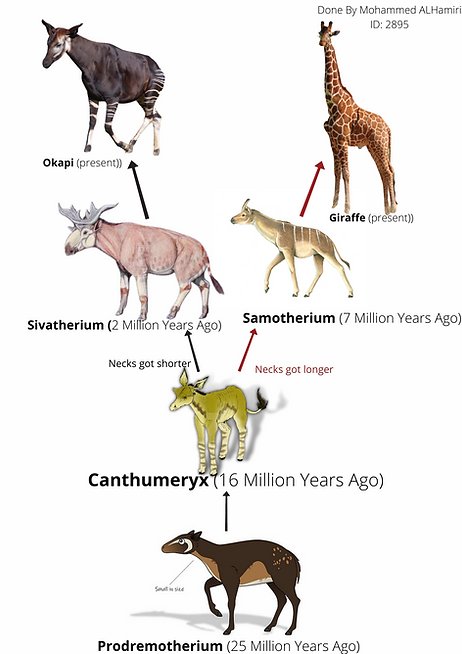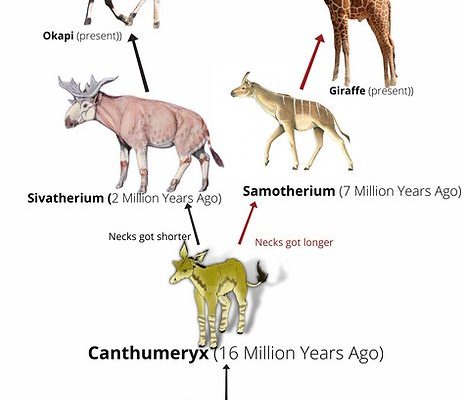
Now, you might be wondering how an animal that looks so striking can also be quite elusive. The okapi is often known as the “forest giraffe” because it shares a common ancestor with giraffes, yet it has developed traits that help it thrive in its dense, jungle habitat. In this article, we’ll journey through the okapi’s evolutionary history, exploring how it came to be, its adaptations, and its current status in the animal kingdom.
Origins of the Okapi
The story of the okapi begins around 20 million years ago. During this period, the ancestors of modern giraffes roamed the Earth, and one branch of these creatures started its unique journey in the dense rainforests of Africa. Think of it like a family tree, with various branches representing different evolutionary paths. Over time, those who adapted better to the forest environment began to develop features we associate with the okapi today.
The okapi’s ancestors were likely herbivores that fed on the abundant vegetation in the rainforests. As they adapted to this habitat, they evolved distinct characteristics. For instance, they developed long, flexible tongues, similar to those of giraffes, which help them reach leaves high in the trees. You might imagine them delicately plucking foliage like a painter choosing colors for a serene forest scene.
By the late Pleistocene epoch, around 12,000 years ago, the okapi had established itself in the Congo Basin. Their journey wasn’t just about survival; it was also about thriving in a unique ecological niche that few other animals could occupy.
Physical Adaptations of the Okapi
Okapis possess a variety of unique physical traits that set them apart from other mammals. Their long necks, for example, are a nod to their giraffe lineage. But here’s the thing—unlike their taller cousins, okapis have necks that are shorter and sturdier, perfect for navigating the dense foliage of their forest home.
Their coat is another fascinating adaptation. The okapi has velvety brown hair that helps it blend into the rainforest shadows, while the striking white stripes on their legs mimic the patterns of zebras. This camouflage protects them from predators, helping them slip silently through the underbrush. Imagine them as stealthy ninjas of the forest, blending in, waiting patiently for the right moment to graze.
In addition to their physical features, they possess a remarkable sense of hearing. With large ears that can pivot in multiple directions, they can detect even the faintest sounds, alerting them to potential threats. This ability to listen closely helps them stay safe in a habitat filled with both sounds and dangers.
Behavior and Social Structure
Okapis might look solitary, often seen grazing alone or in pairs, but they actually have a complex social structure. They communicate through a variety of sounds, including low-frequency calls that can travel long distances. Picture them as whispering secrets to each other in the quiet of the forest. These vocalizations are crucial for maintaining social bonds and coordinating activities with one another.
Interestingly, okapis are also known to mark their territories using scent. They have special glands on their hooves and skin that leave behind a unique smell, letting others know who’s been in the area. Think of it as leaving a subtle calling card in the vast expanse of the jungle. This social interaction and communication play a significant role in their lives, even in the dense forests where they live.
Moreover, the okapi’s foraging behavior is quite unique. They are browsers, primarily feeding on leaves, buds, and fruits. You might find them stretching their long tongues around branches to reach those hard-to-get leaves that other herbivores can’t access. They play an essential role in their ecosystem, helping to disperse seeds and maintain the health of their forest home.
Conservation Status and Challenges
Despite their unique adaptations, okapis face numerous challenges today. The biggest threats come from habitat loss due to deforestation, mining, and human encroachment on their natural environment. Imagine having your home slowly taken away piece by piece; that’s what okapis are experiencing. The loss of forests not only reduces their habitat but also impacts the delicate balance of the ecosystem they rely on.
Additionally, poaching poses a significant risk. Okapis are often hunted for their skins and meat, which further threatens their populations. Conservation efforts are underway to protect these beautiful animals, with organizations working to raise awareness and implement protective measures. It’s a tough battle, but every little effort counts.
Conservationists are promoting the establishment of protected areas and sustainable practices that allow local communities to thrive alongside these animals. Education is also crucial; teaching locals about the importance of the okapi in their ecosystem can lead to a greater appreciation and protection of these animals.
The Role of Okapis in Culture
The okapi’s fascinating appearance and elusive nature have earned them a place in the hearts of many people around the world. They are often featured in art, folklore, and even as mascots for conservation campaigns. In fact, the okapi has become a symbol of the mysterious and uncharted aspects of the African rainforest.
Many local communities regard the okapi as a spiritual animal, representing the interconnectedness of all living things. This cultural significance helps promote conservation efforts, as it ties the survival of the okapi to the identity and heritage of these communities. Imagine the pride of a community that sees the okapi as part of their shared story—it creates a strong motivation to protect this magnificent animal.
Zoos and wildlife parks also play a crucial role in educating the public about okapis. By showcasing these animals, they help raise awareness and funds for conservation initiatives. People often leave the zoo with a sense of wonder and a desire to safeguard these unique creatures, becoming advocates for their conservation.
The Future of the Okapi
Looking ahead, the future of the okapi depends on continued conservation efforts and public awareness. With habitat loss and poaching still looming over their populations, it’s crucial to stay informed and active in conservation campaigns. Many dedicated organizations are working tirelessly to secure the future of the okapi, implementing initiatives to protect their habitats and promote coexistence with local communities.
Innovative solutions are being explored, like eco-tourism, that can provide income to local communities while protecting the natural environment. By drawing attention to the beauty and importance of the okapi, these efforts not only help save the species but also foster a greater understanding of the delicate balance of ecosystems.
In essence, the okapi’s story is one of resilience and adaptation. They’ve survived against the odds, and with our help, they can continue to thrive in their natural habitat. Let’s keep spreading the word about these remarkable animals and ensure that their legacy endures for future generations.
In conclusion, the evolutionary history of the okapi is not just about their physical traits; it’s also a story of survival, community, and the importance of biodiversity. By understanding their journey, we can appreciate the complexity of life in the rainforests and the need to protect these unique beings. Whether you’re an animal lover or simply curious, the okapi offers a glimpse into the wonders of evolution and the ongoing struggle for survival in our changing world.

